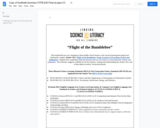
Flight of the Bumblebee Anchor Text Scaffolds Summary
- Subject:
- English Language Arts
- Life Science
- Material Type:
- Lesson Plan
- Date Added:
- 10/18/2022

Flight of the Bumblebee Anchor Text Scaffolds Summary
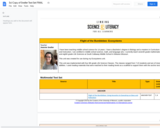
Flgiht of the Bumblebee Text Set - Jeannie Sneller - Science
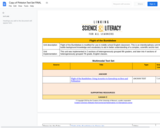
Flight of the Bumblebee Text Set - Pinkston - ELA

This lesson is about forest fires and wildfires.

Students will explore the outdoor classroom finding objects and determining how to form different letters using them.
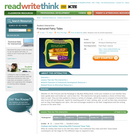
The Fractured Fairy Tale tool encourages students to create their own fractured fairy tales.
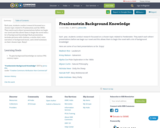
Each year, students conduct research focussed on a chosen topic related to Frankenstein and the 1800s. They watch each others' presentations before we begin our novel and this allows them to begin the novel with a lot of background knowledge!
Each presentation includes pictures with citations, a works cited, voice narration or background music, and a brief summary on their chosen topic. Enjoy!
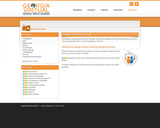
Several full course OER offerings in ELA, Math, Science, Social Studies, World Languages, Fine Arts
This Lesson Plan was created by Joanna Pruitt as part of the 2020 ESU-NDE Remote Learning Plan Project. This original lesson is for classroom use; however, there is a virtual option as well. Educators worked with coaches to create Remote Learning Plans as a result of the COVID-19 pandemic. The attached Lesson Plan is designed for Grades 9-12 English Language Arts students; however, this could also be used as a Social Studies project as well. Students will evaluate credible sources through research on genocides post World War II after completing a novel unit covering the Holocaust. Students will also create scrapbooks using summarizing, citation, informative writing, textual evidence, caption writing, and persuasive writing. Students will also be expected to demonstrate oral communication skills as they have to present their projects to the class. Students will use background knowledge to clarify text and also gain a deeper understanding by using relevant evidence from a variety of sources to assist in analysis and reflection of informative text.
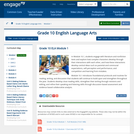
In Module 10.1, students engage with literature and nonfiction texts and explore how complex characters develop through their interactions with each other, and how these interactions develop central ideas such as parental and communal expectations, self-perception and performance, and competition and learning from mistakes.
Find the rest of the EngageNY ELA resources at https://archive.org/details/engageny-ela-archive .

In this module, students read, discuss, and analyze poems and informational texts focusing on how authors use rhetoric and word choice to develop ideas or claims about human rights. Students will also explore how the nonfiction authors develop arguments with claims, evidence, and reasoning. The texts in this module offer rich opportunities to analyze authorial engagement with the struggle for human rights and to consider how an author’s rhetorical choices advance purpose.
Find the rest of the EngageNY ELA resources at https://archive.org/details/engageny-ela-archive .
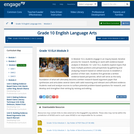
In Module 10.3, students engage in an inquiry-based, iterative process for research. Building on work with evidence-based analysis in Modules 10.1 and 10.2, students explore topics that have multiple positions and perspectives by gathering and analyzing research based on vetted sources to establish a position of their own. Students first generate a written evidence-based perspective, which will serve as the early foundation of what will ultimately become a written research-based argument paper that synthesizes and articulates several claims with valid reasoning and relevant and sufficient evidence. Students read and analyze sources to surface potential problem-based questions for research, and develop and strengthen their writing by revising and editing.
Find the rest of the EngageNY ELA resources at https://archive.org/details/engageny-ela-archive .
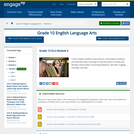
In this module, students read, discuss, and analyze nonfiction and dramatic texts, focusing on how the authors convey and develop central ideas concerning imbalance, disorder, tragedy, mortality, and fate.
Find the rest of the EngageNY ELA resources at https://archive.org/details/engageny-ela-archive .
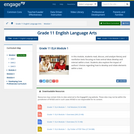
In this module, students read, discuss, and analyze literary and nonfiction texts focusing on how central ideas develop and interact within a text. Students also explore the impact of authors’ choices regarding how to develop and relate elements within a text.
Find the rest of the EngageNY ELA resources at https://archive.org/details/engageny-ela-archive .
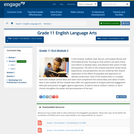
In this module, students read, discuss, and analyze literary and informational texts, focusing on how authors use word choice and rhetoric to develop ideas, and advance their points of view and purposes. The texts in this module represent varied voices, experiences, and perspectives, but are united by their shared exploration of the effects of prejudice and oppression on identity construction. Each of the module texts is a complex work with multiple central ideas and claims that complement the central ideas and claims of other texts in the module. All four module texts offer rich opportunities to analyze authorial engagement with past and present struggles against oppression, as well as how an author’s rhetoric or word choices strengthen the power and persuasiveness of the text.
Find the rest of the EngageNY ELA resources at https://archive.org/details/engageny-ela-archive .
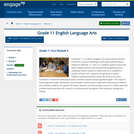
In Module 11.3, students engage in an inquiry-based, iterative process for research. Building on work with evidence-based analysis in Modules 11.1 and 12.2, students explore topics that have multiple positions and perspectives by gathering and analyzing research based on vetted sources to establish a position of their own. Students first generate a written evidence-based perspective, which will serve as the early foundation of what will ultimately become a written research-based argument paper. The research-based argument paper synthesizes and articulates several claims using valid reasoning and relevant and sufficient evidence to support the claims. Students read and analyze sources to surface potential problem-based questions for research, and develop and strengthen their writing by revising and editing.
Find the rest of the EngageNY ELA resources at https://archive.org/details/engageny-ela-archive .
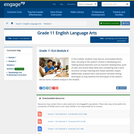
In this module, students read, discuss, and analyze literary texts, focusing on the authors’ choices in developing and relating textual elements such as character development, point of view, and central ideas while also considering how a text’s structure conveys meaning and creates aesthetic impact. Additionally, students learn and practice narrative writing techniques as they examine the techniques of the authors whose stories students analyze in the module.|
Find the rest of the EngageNY ELA resources at https://archive.org/details/engageny-ela-archive .
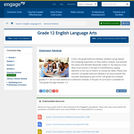
In this 12th grade Extension Module, students can go deeper into analyzing arguments, as they outline, analyze, and evaluate the claims that Michelle Alexander makes in|The New Jim Crow: Mass Incarceration in the Age of Colorblindness, paying attention to her use of rhetoric to convey her ideas. Please note that this 12th grade Extension Module is an extra module that has been developed as part of the 12th grade ELA modules; grades 9-11 do not have additional or extension modules. A full year of curriculum is available for 12th grade through modules 1-4.
Find the rest of the EngageNY ELA resources at https://archive.org/details/engageny-ela-archive .
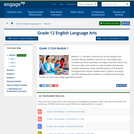
Module 12.1 includes a shared focus on text analysis and narrative writing. Students read, discuss, and analyze two nonfiction personal narratives, focusing on how the authors use structure, style, and content to craft narratives that develop complex experiences, ideas, and descriptions of individuals. Throughout the module, students learn, practice, and apply narrative writing skills to produce a complete personal essay suitable for use in the college application process.
Find the rest of the EngageNY ELA resources at https://archive.org/details/engageny-ela-archive .
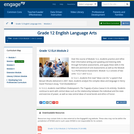
Over the course of Module 12.2, students practice and refine their informative writing and speaking and listening skills through formative assessments, and apply these skills in the Mid-Unit and End-of-Unit Assessments as well as the Module 12.2 Performance Assessment. Module 12.2 consists of two units: 12.2.1 and 12.2.2. In 12.2.1, students first read “Ideas Live On,” a speech that Benazir Bhutto delivered in 2007. Next, students analyze the complex ideas and language in Henry David Thoreau’s essay, “Civil Disobedience.”
Find the rest of the EngageNY ELA resources at https://archive.org/details/engageny-ela-archive .